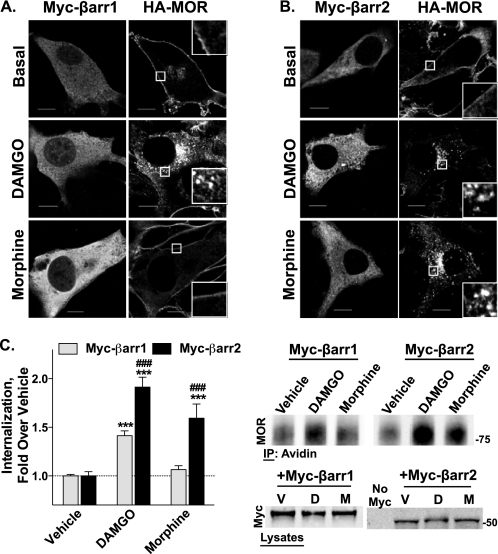FIGURE 4.
β-Arrestin rescue of HA-MOR internalization in βarr1/2-KO MEFs. HA-MOR βarr1/2-KO MEFs were transiently transfected with either Myc-βarr1 or Myc-βarr2 and treated with DAMGO (1 μm) or morphine (10 μm) for 2 h. A and B, confocal microscopy. Receptor internalization was detected by anti-HA immunocytochemistry following drug treatment. Myc-β-arrestins are labeled with an anti-Myc antibody, followed by an anti-mouse secondary AlexaFluor 568 conjugate (fluorescence on the left side of each panel). HA-MOR is labeled using anti-HA AlexaFluor 488 conjugate (right side of each panel; inset, ×4 magnification). A, expression of Myc-βarr1 rescues HA-MOR internalization only by DAMGO and not morphine. B, expression of Myc-βarr2 rescues both DAMGO- and morphine-induced HA-MOR internalization. Representative images are shown from at least three experiments (scale bars, 10 μm). C, biotinylation. Agonist-induced HA-MOR internalization was quantified using cell surface biotinylation assays. Densitometric analysis of three experiments done in duplicate or triplicate shows the mean ± S.E. (error bars) of internalized HA-MOR. Expression of Myc-βarr2 rescues both DAMGO- and morphine-induced internalization, whereas Myc-βarr1 transfection rescues only DAMGO-induced HA-MOR internalization (one-way ANOVA, p < 0.0001; Bonferroni's multiple comparison test, p < 0.001 (***) versus vehicle of the same transfection and p < 0.001 (###) versus Myc-βarr1 with the same treatment; n = 4–8). Representative immunoblots of biotin pull-downs and Myc transfections are shown.

